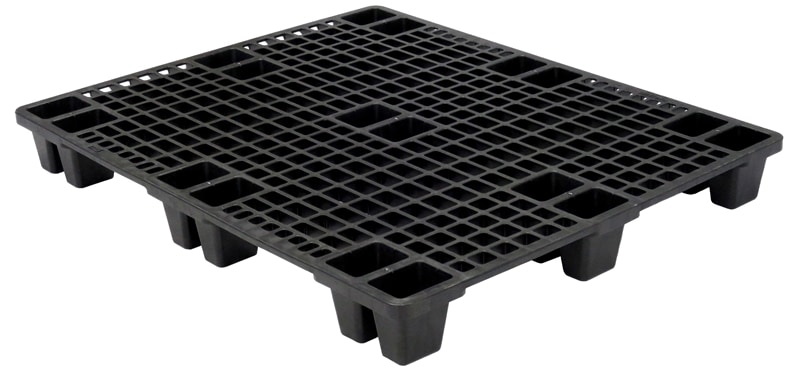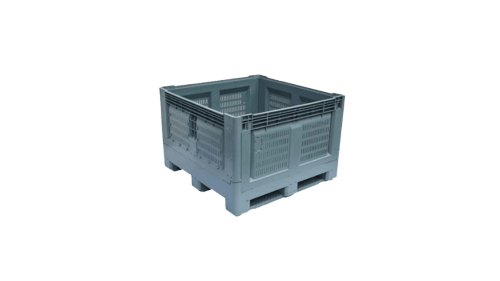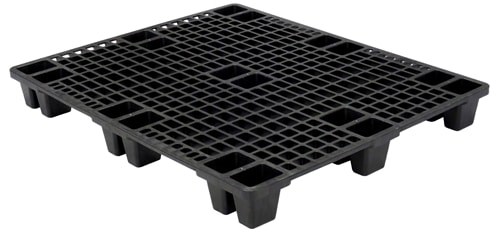Although people often use the terms interchangeably, the real distinction between a skid and a pallet lies in how the main platform receives support. Grasping this difference is vital for ensuring the most efficient transportation and storage of your goods, streamlining your entire logistics operation.
What are the differences between a pallet and a skid?
Despite their differences, even industry workers often confuse the two terms, which makes determining what you really need quite confusing. Skids and pallets resemble each other in terms of look, design, and purpose. Both serve as types of square platforms designed to support weight for storage or transportation.
The main difference lies in the construction underneath. Typically, ‘feet’ or ‘pedestals’ support skids under the loading deck. In contrast, three or four stringers across the pallet’s length in either direction provide support to pallets.
Designs do indeed vary. Some skids have full-length ‘runners’ in place of feet, all aligned in the same direction to facilitate a gliding motion during transport. Conversely, certain pallets have more supporting beams than others and might include both top and bottom platforms or decks.
Additionally, some pallets come equipped with top and bottom decks and have multiple support points. This structure can enhance its stability and capacity to carry weight.


Should you buy a pallet versus a skid?
Whether you should buy a plastic pallet or a skid comes down to how and when you’ll be using it. Both designs have benefits, and your decision should be based on how they’ll fit into or improve your existing operations.
When to buy a skid:
Skids come into their own when you need to store empty pallets in a minimal space. You may also see them referred to as nestable pallets because the feet of the skid can be designed to sit inside each other so they take up less room vertically when not in use. Nested pallets allow you to fit a larger number of them into a shelving unit, or cut shipping costs by booking smaller spaces.
They’re easier to move when loaded as there’s less friction to compete against – particularly helpful when storing heavy equipment that needs moving around regularly. It also means they can be dragged or hauled and can glide through difficult or uneven terrain, such as sand.


When to buy a pallet:
Pallets truly excel when you require strength and stability. The additional support lets the pallet bear more weight without succumbing to pressure – especially with an uneven load across the platform. The extra friction created by the more extensive supports reduces the likelihood of slipping or sliding. Moreover, the design of pallets accommodates a range of machinery to ensure that you can store them at height and fully loaded.
What to consider when buying pallets and skids
- Pallet jacks and forklifts – At some point, you need to move your skid or pallet, whether it’s loaded or not. You must understand the equipment necessary for handling and lifting to ensure your operations run smoothly.
- Weight-bearing – Consider all items you might want to store on your pallet or skid to accurately determine the weight it needs to bear. If you guess or don’t properly consider how you’ll use your purchase, you could end up with a product that doesn’t meet your requirements.
- Racking and shelving – You’ll need to store your loaded and unloaded pallets, and often warehouses utilize racking and shelving to maximise storage space. Consider the equipment needed to store fully loaded pallets or skids in your storage.
- Supply chain requirements – You must ensure that whatever you use fits into your entire supply chain. The design must not only suit your warehouse but also all sections of your transportation network, including those run by third parties. Examine the trucks and containers used throughout the delivery process.
- Materials used – Various materials, including plastic, wood, metal, and cardboard, make up pallets, while skids are more often made from plastic or cardboard. If your organisation has pledged to recycling, sustainable sourcing, or reusable pallets, the materials used might play a critical role in your decision-making process.
Crates ensure your load arrives in one piece, no matter how you have to transport it.
When neither a skid nor pallet will do:
If neither a pallet nor a skid sounds quite right, here’s your secret third option – a crate. Fantastic for protecting goods from harm during transit, plastic pallet crates are designed with robust sides, and securely fitted lids for extra safety. Especially popular in industries with easily damaged goods, such as grocery manufacturers, pharmaceutical suppliers, and textiles producers, crates ensure your load arrives in one piece no matter how you have to transport it.
Top-of-the-range crates like the newly released Oz Crate fold down into a slimline design to optimize storage during or after transportation. Meanwhile, you can also fold down the crate’s sides to facilitate easy access to the goods inside when you don’t need to unload everything at once, and individual items require less protective packaging.
For more advice about which type of pallet, skid or crate suits your individual needs, get in touch with the Eco Pallets team. Our experienced advisors can help you make your business more efficient today.
Next Read: Learn About Australia’s Standard Pallet Size For Export









